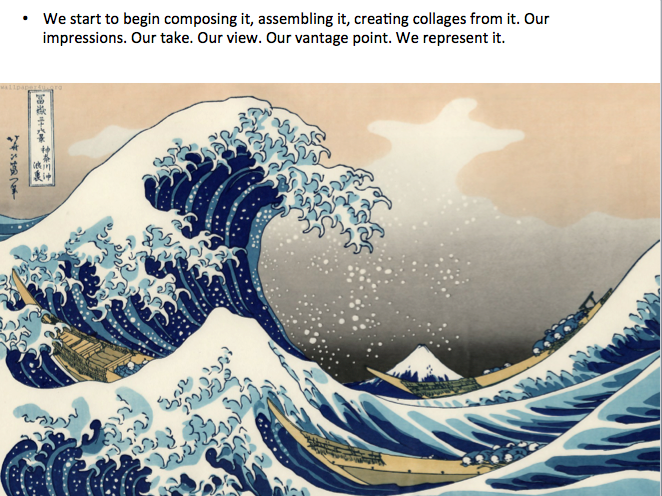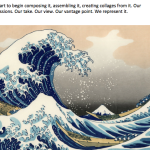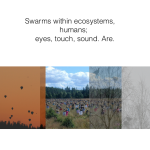My colleague Pekka Ihanainen and I will be in Edinburgh in April for the Networked Learning Conference and will be presenting our paper titled “Mobile Learning Field Activity: Pedagogy of Simultaneity to Support Learning in the Open.” This is the latest output from what has been a few years of collaboration on a host of projects, one of which will soon see the light of day after he visits Seoul late next week. Pekka and I collaborate well and so I thought it might be useful to describe how we do this from Finland and Korea, respectively. We rarely video chat; the vast majority of our discussion takes place through email, Twitter, Dropbox, or Google Drive.
We are attempting to boil down the Pedagogy of Simultaneity (PoS) into a compelling visual presentation for the conference. We are nowhere near complete. We are just going back and forth with any number of methods in an attempt to elicit metaphors or themes or structures for the presentation. This is essentially an exercise in transduction, or a multimodal exercise of translating from one mode to another (and then another). It really stretches the brain in a good way, forces a lateral rethink on things you thought you knew, at least in one textual mode. It has generated a lot of fun media, much of which I present here.
First the revenant details, i.e. the abstract from the paper.
Abstract
“Mobile learning field activities are presented in this paper as a mechanism for enacting learning in the ‘open’, either in response to formal disciplinary learning activities or to support those moored in informal learning practices. Field activity represents a disciplinary model found across the (field) sciences and throughout the humanities. It has traditionally involved using disciplinary process (observation, data collection, analysis, dissemination) to research social or biological phenomena. Mobile technology has accelerated the process and potential for “coming to know” in the field by allowing the learner to engage multiple layers of meaning, social presence, time, and place simultaneously. These mobile learning field activities represent an authentic application of both informal and formal learning, and include, by way of example, learning walks, geocaching, and urban exploration. Examples presented in this paper include a mobile learning field activity presented in Helsinki, Finland.
However, the context, content, and social interactions of this learning can be incredibly complex. This complexity requires a pedagogical response that acknowledges this complexity, identifies the layers of engagement and simultaneous activity taking place, and proposes strategies that maximizes the potential of learning in the open (or in the field). This paper identifies three continuums in which this simultaneous activity is taking place: the serendipity-intentionality of learner orientation, the informal-formal activity structure and the initiative-seduction-sense of intervals continuum of human presence. All three speak to the variety of learner engagements that occur as a result of mobile learning and field activity.
This paper advances the belief that new pedagogical approaches are needed to account and make use of these continuums of activity. These layers overlap and are simultaneously engaged in by the learner to generate context and understanding in fluid mobile spaces. The Pedagogy of Simultaneity is proposed to account for these layers of overlap and simultaneity. It advances a pedagogical response by emphasizing human methods. These methods are enacted through trust, discussion, and collage (or composition). Teachers can generate field activities that emphasize this layered reality for learning. This pedagogy addresses the complexity and simultaneity present in mobile learning field activities and we are cautiously optimistic that it also applicable to open learning and elearning.”
Next Step: Representative (Emotionally) Images
Working from the paper, we both then started exchanging visual representations of what we thought PoS is. Some of these visual representations were more thought out than others. It was just an attempt to see what stuck or resonated in terms of a design metaphor for the larger presentation.
This is challenging first bit of multimodal transduction. We patiently look for accuracy and efficiency in choosing the right modal equivalent, but this isn’t the way it necessarily works. I might want a perfect approximation of one textual passage into an image or video, but it isn’t a straight line to that point. We start with one mode, we plunge into the contours of another, and then we find our way to the shore of the other mode with an acceptable translation. To get from one island to the other, you have to jump into the water. So we did. Unabashedly and without any sense of self-awareness. We simply chose images that felt right, that we had a hunch might be pushing towards representation.
Next Step: Extracting Themes
From there, we used these images to start mapping our own ideas about what PoS was and what it entailed. These developed rather quickly into mixtures of images and text, but it was a useful process of layering ideas over our lived worlds. It might seem like just a cosmetic change, this process of marking up images, but you might be surprised as to how much this actually effects the text that you are mapping over it. A useful process, but I can’t come close to improving on Pekka’s illustrations as seen below.
In keeping with the Pedagogy of Simultaneity that assumes we are experiencing multiple engagements with time simultaneously, I literally cannot remember if this presentation came before or after these mapping as presented above. But it doesn’t matter. By this point, Pekka and I were generating incessant media to try and represent clearly this pedagogy of ours. The process had taken over and we were merely acting as vehicles towards some sort of negotiated understanding of a set of difficult concepts. So we developed a short presentation using water as a centralizing metaphor for how learning works in these complex spaces. Some slides below:
So that is how we proceeded and that is how we will continue to proceed. Pekka and I work best in a loose aggregation of structure and a great diversity of methods. I suspect we would both feel a bit too constrained to work strictly in a document. We routinely float through different tools or systems to present our meaning any which way we feel is necessary or, sometimes, possible. We feel these methods are, for lack of a better term, human. They are messy and don’t always work in the sense that they end up generating the final output, presentation, or paper. But they always work in the sense that they generate additional layers of understanding or capacity for interacting with ideas across modes, across communities, across our respective countries and time zones. A great collaboration, for sure. I leave you with the conclusion for the paper we are presenting as I think it will help make sense of this imagery. Before I do, I conclude with the following: relentlessly experiment with form and structure and modes; these incessant experiments directly effect meaning, content, and ideas. The application of all theory depends on it. Get messy.
Conclusion
“The kind of learning being enacted in mobile learning field activities is often complex and chaotic, where meaning is being perpetually constructed and context shifts to create that meaning and evolves as a response to it. This learning is a heady, complex process of the employing intellectual, social, emotional and technological tools towards a process of coming to know (Saljo, 1999). This process of coming to know is accelerated by mobile technology; mobile learning, as a result of this acceleration, is an environment of overlap and simultaneity, where layers of time, social presence, and place are engaged with repeatedly by the learner to generate meaning.
This environment of overlaps and simultaneity, along with the emergence and humaneness found in the overall quality of PoS, challenges educators to generate pedagogically appropriate responses and designs for mobile learning in field activities and to make use of them. The Pedagogy of Simultaneity (PoS) is one such response that is explicitly designed to account for the simultaneity of purpose, place, social presence, and layers of time present in mobile learning. It acknowledges that the intersections of these simultaneities are fertile learning spaces; in response to this complexity, PoS emphasizes methods that are distinctly human: trust, discussion, and collage. It emphasizes learners that “artfully engage their surrounding to create impromptu sites of learning” (Sharples et al, 2007) through social interaction and creative composition; learners that transform their habitus (Kress, Pachler, 2007) in response to both intentionality and serendipity. It is a pedagogy specifically designed for the simultaneity being generated in mobile learning.
The pedagogical approaches outlined in PoS are designed to address the particular learning environments as outlined in these mobile learning field activities, but we believe they are not exclusive to mobile learning. Indeed, the authors believe that this pedagogy has application to elearning, open learning, and informal learning. The field activities presented in this paper are merely one example of where this complexity is enacted. This is learning in the open and it requires a pedagogically appropriate response, one that seeks to understand and make use of these mobile learning engagements. Further research is needed to determine the applicability of this pedagogy to open, informal, and elearning environments.”





















[…] way of structuring my time, identity, or community (which speaks to some of the work I do with Pedagogy of Simultaneity). However, the definition, however beautiful (at least in comparison to most academic writing), […]